| Houses of Worship in KL 31-1-2014 |
| On the first day of the Chinese Year of the Horse, my friend Joe Yap and I decided to spend a day in Kuala Lumpur and visit as many Houses of Worship as we could. Using the Internet we had prepared a map with more than twenty Churches, Mosques, Temples, Viharas, Kovils and Gurdwaras, all in Kuala Lumpur.
It was a fascinating trip, many of these "God houses" we had never seen before. Naively we thought that Kuala Lumpur would be very quiet on the first day of the CNY, but when we came near our first destination, the Thean Hou temple, we realised our mistake! The Chinese temples are crowded on that day, many people come to pray for good luck in the new year! So we skipped this Taoist temple and also later a few of the mosques, when we realised that it was a Friday. Altogether we visited 21 houses of worship. The following report is chronological.
We started in Brickfields with the Tamil Methodist Church, a modern church with an interesting triangular architecture.On our way to the huge complex of the Buddhist Maha Vihara we passed a small Hindu temple, the Kalamman Alayam Temple. Brickfields has a large concentration of religious places. The origin of the name is interesting: In 1881 Kuala Lumpur (not yet more than a village) was hit by a devastating fire, followed in the same year by a severe flooding. The British resident, Swettenham, decided that all future buildings should be constructed of bricks and Brickfields was where the brick factories were located. |
 Tamil Methodist Church
|
 Kaliamman Alayam Temple
|
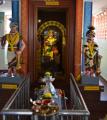 Interior
|
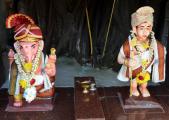 Ganesha and Murugan, two sons of Shiva
|
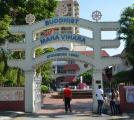 Entrance of the Buddhist Maha Vihara
|
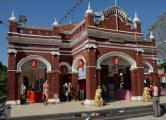 Main Hall
|
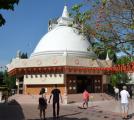 Dagoba
|
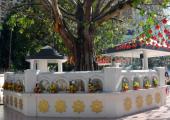 The Bodhi tree
|
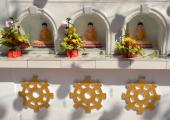 Detail
|
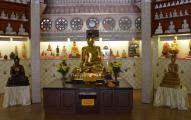 Inside the Vihara
|
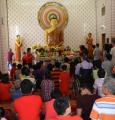 Devotees praying
|
|
It is easy to spend much time in the Maha Vihara, even with many devotees it still has a quiet and serene, typical (Theravada) Buddhist atmosphere. The Zion Lutheran Cathedral (1924) was next on our list. Attractive architecture, a pity that it was (like all other Christian churches we visited) closed. Churches should be open for prayer all the time, not only on Sundays.
It took us some effort to find the Vivekananda Ashram (1904), as the GE location turned out to be wrong. An Ashram is not really a place of worship but more a spiritual hermitage.
The impressive Sri Kandaswamy Kovil was built between 1902 and 1907 on the banks of the Klang river by Sri Lanka Tamils. Beautiful decorations. But as many other places we visited, dwarfed these days by modern buildings towering above them.
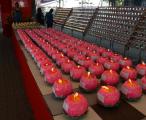 Many candles
|
 A Buddha snrine
|
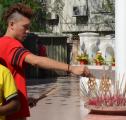 Nice hair style
|
 Some of the monks
|
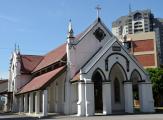 Zion Lutheran Cathedral
|
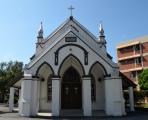 Front facade
|
 Church tower
|
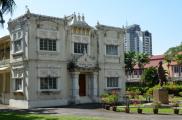 Vivekananda Ashram
|
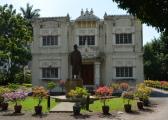 Front view
|
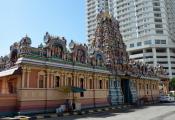 Sri Kandaswamy Kovil
|
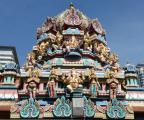 Detail
|
|
After Brickfields we went to Chinatown with, not surprisingly, a concentration of Taoist temples. And a crowd of foreign workers, enjoying their holiday here!
First we visited the Sze Ya temple. Founded in 1864 by the famous Yap Ah Loy, the Kapitan Cina who has been instrumental in the development of KL. Relocated to the present location in 1885, it may be one of the oldest buildings of KL. Inside the temple it is almost painful for your eyes with the smoke of the hundreds of joss sticks being burnt.Nearby is the Guan Di Temple from 1888, dedicated to the God of War. Even more popular than the Sze Ya. One of the attractions is the 59 kg copper Guan Dao, a weapon/pole, which brings luck if you can lift it. I managed to lift it a bit, it broke almost my back...
 Sze Ya Temple
|
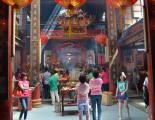 Inside the temple
|

|

|
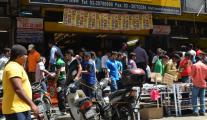 Crowds in Chinatown
|
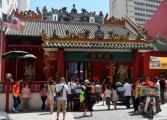 Guan Di Temple
|
 Entrance guardian
|
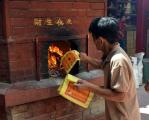 Burning joss money
|
 Decorative lantern
|
 A deity
|
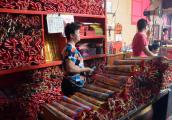 Selling joss sticks
|
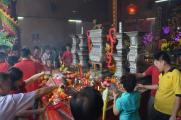 Offering joss sticks
|
|
After these two busy Chinese temples, we had a quick look at the well-known Hindu Mahamariamman Temple in Petaling street, and next to the much lesser known Sikh Gurdwara located at the Petaling Police station.
In the early history of KL, many of the police force were Sikhs, that's why this Gurdwara was established already end of the 19th century. Of course I had to cover my head before I could go inside.
After this intermezzo back to Chinese culture. The Green temple is actually not a temple but the Chan See Shu Yuen clan house. Closed, but the exterior is beautifully decorated.
Almost next door is the Kuan Yin temple, dedicated to the Goddess of Mercy, also dating back to the end of the 19th century .
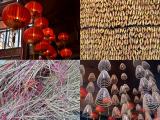 Details
|
 Trying to lift a heavy pole
|
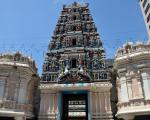 Mahamariamman Temple
|
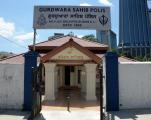 Gurdwara Sahib Polis
|
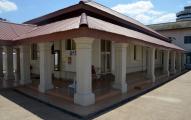 The Gurdwara
|
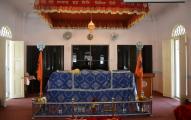 Inside the gurdwara
|
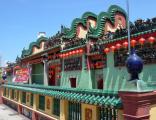 Chan See Shu Yuen clan house
|
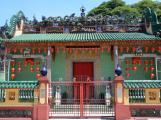 a.k.a the Green Temple
|
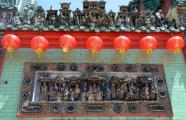 Detail
|
 Detail
|
 Wei Zhen Gong Guan Yin temple
|
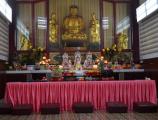 Inside the temple
|
 Praying
|
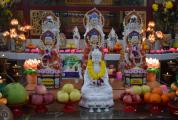 Detail
|
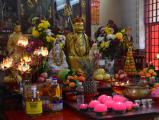 Another shrine
|
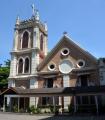 Wesley Methodist Church
|
|
After Chinatown, it was time to go back to the other religions. The Wesley Methodist church (Protestant) must be old, but I could not find out when it was actually built.
Next was the Masjid Al-Bukhary, a modern mosque, where we we saw many people praying and realised that this CNY was also a Friday, so we decided to skip most of the other mosques on our list.
After one more Christian church, St Anthony church (1913), it was time to look for a suitable lunch location. Not that easy on the first day of CNY! Joe suggested Jalan Alor, a tourist place, and indeed, there were quite a few restaurants open. We had Dim Sum for a reasonable price...:-)
 Masjid Al-Bukhary
|
 View of the mosque
|
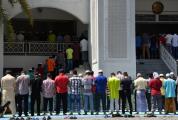 Friday prayer
|
 St Anthony Church
|
 Side view
|
 Facade
|
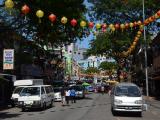
|
|
Refreshed we continued, with St Andrew's, a Presbyterian church next to Bukit Nanas and again in the shadow of skyscrapers.
From there to St John's cathedral, originally the only Catholic church in Selangor, in 1883, but rebuilt in 1954. Next to it the impressive St John's Institution, founded in 1904 by the La Salle brothers. In front of the main building a statue of Saint Jean Baptiste de la Salle with two young boys.
Would probably cause some concern in these days...:-)
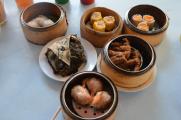 Dim Sum lunch
|
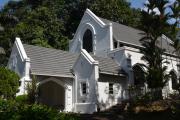 St Andrew's Church
|
 Skyscraper as background
|
 St John's Cathedral
|
 Very tall towers
|
 Detail
|
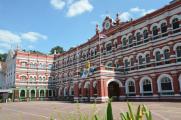 St John's school
|
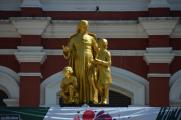 A priest with students
|
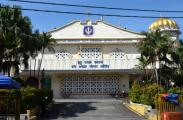 Tatt Khalsa Diwn Gurdwara
|
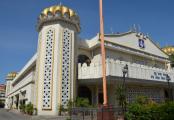 Another view
|
|
| I did not know that Chow Kit has a huge Sikh Gurdwara, the Tatt Khalsa Diwan, founded already in 1924, but the present building dates from the 1990's. I was allowed to enter, but again had to cover my head. On the way back we got caught in a traffic jam, I only could take a picture of the Masjid India. We had a look at St Mary's Cathedral, built in English Gothic style in 1895, near Dataran Merdeka. Our last church for the day was also the most beautiful one, the Holy Rosary Church, built in French Gothic Revival style and completed in 1904. Similar style as St Anthony's, but more elaborate. A real gem.
The last two pictures show the map we used during our hike and a GE map of the route we have followed. A perfect outing, not bad for a secular humanist...:-)
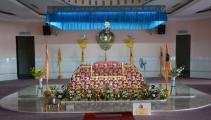 Inside the Gurdwara
|
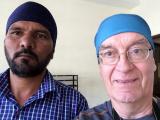 Had to cover my head
|
 Detail interior
|
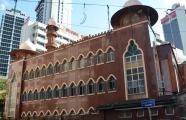 Masjid India
|
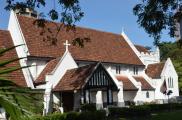 St Mary's Cathedral
|
 Holy Rosary Church
|
 Most beautiful churvch of KL
|
 The map we used
|
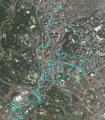 The route we took
|
|
 |
lightlingmk2 wrote on Feb 16, 2014:
The reason why churches are under locks and keys are because of the fear of destructions, I think.I do not know most of these places.
|
|
|
 |
You are welcome to comment, but you must register and/or
login first.
|
|













































































